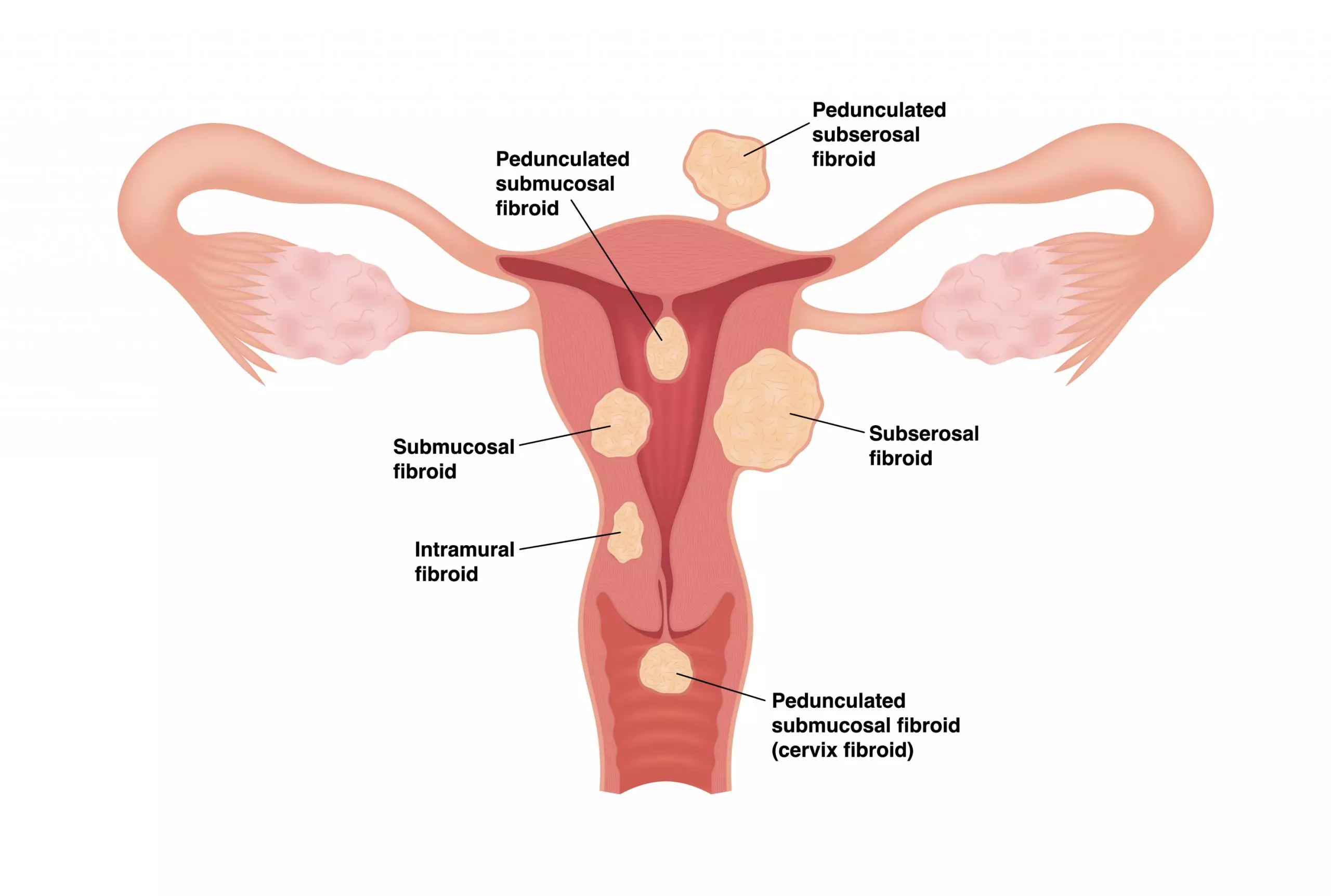What Are Pedunculated Fibroids?
The four main types of uterine fibroids are categorized by where they grow in or on your uterus, and how they are attached. Pedunculated fibroids grow on stems that can be attached either to the inside or outside of your uterus. Here is an overview of the nature, symptoms, diagnosis, and treatment of pedunculated fibroids.
About Pedunculated Fibroids
Pedunculated fibroids are fibroids that are attached to the uterus by slender stems or stalks called peduncles. When these grow on the outer wall of the uterus and project toward the pelvis, they are called pedunculated subserosal fibroids. When they are located inside the uterine cavity and project inward toward the center, they are pedunculated submucosal fibroids. Fibroid stems are made of the same smooth muscle as the fibroids themselves, and range in size from 5 mm to 10 cm in diameter. Fibroids without stems are referred to as sessile fibroids.

This diagram shows where each type of fibroid is located in relation to the uterus
(This image is from Shutterstock.)
Symptoms of Pedunculated Fibroids
Like other fibroids, pedunculated fibroids may not cause any symptoms at all, or they may cause:
- Heavy and/or prolonged periods
- Spotting between periods
- Pelvic, abdominal, and/or lower back pain
Depending upon their size and placement, pedunculated fibroids can interfere with fertility, pregnancy, and vaginal childbirth by blocking your fallopian tubes, preventing a fertilized egg from anchoring to the uterus, and crowding out a developing fetus.
Subserosal pedunculated fibroids are more likely to cause pain and pressure in your abdomen, while submucosal ones are more commonly responsible for fertility issues and heavy menstrual bleeding.
Unlike sessile fibroids, pedunculated fibroids can become torqued. Torsion occurs when a fibroid twists on its stem, cutting off its own blood supply. This can cause sudden, severe abdominal pain. While the pain may be short-lived, you should seek medical attention immediately to avoid the possibility of gangrene setting in.
If you are planning a pregnancy, find out where your fibroids are located, how many there are, and how quickly they are growing.
Diagnosing Pedunculated Fibroids
Diagnosing pedunculated fibroids is accomplished the same way as for any other fibroids: through a pelvic exam performed by a gynecologist, and possibly with a transvaginal ultrasound or other imaging tests such as a CT scan or MRI. Like other fibroids, pedunculated fibroids can grow individually or in clusters. Imaging tests can provide important information about the number, size, and location of your fibroids.
Unfortunately, torqued fibroids cannot be seen on imaging tests, making them difficult to diagnose without surgery. As a result, many torqued fibroids are misdiagnosed as degenerating fibroids. Research suggests that a CT Scan of the pelvis with IV contrast material may help identify fibroid torsion without surgery, but further studies are needed.
Treating Pedunculated Fibroids
If your pedunculated fibroids aren’t causing you pain or complications, then you may not need to address them. As long as they remain present in your body, however, there is the possibility of torsion, though occurrences are rare. If the fibroids are interfering with your life and health, then the standard treatments for all types of fibroids and their symptoms may be options. These include:
- Medications such as over-the-counter nonsteroidal anti-inflammatory drugs
- Hormonal therapies such as birth control pills and gonadotropin-releasing hormone agonists (GnRH)
- Non-invasive magnetic resonance-guided focused ultrasound (MRgFUS), also known as myolysis
- Minimally-invasive procedures including:
- uterine artery embolization (UAE), which shrinks both the fibroid and the stem
- radiofrequency ablation (RA)
- laparoscopic or robotic myomectomy
- hysteroscopic myomectomy
- endometrial ablation (helps with heavy bleeding but does not address fibroids)
- Major surgery, specifically abdominal myomectomy or hysterectomy
Surgical removal, via either laparoscopic or hysteroscopic myomectomy, is the only treatment for a torqued pedunculated fibroid.
If you are experiencing symptoms that interfere with your quality of life or family planning, speak with your healthcare provider about which treatment option(s) may be best for you.


